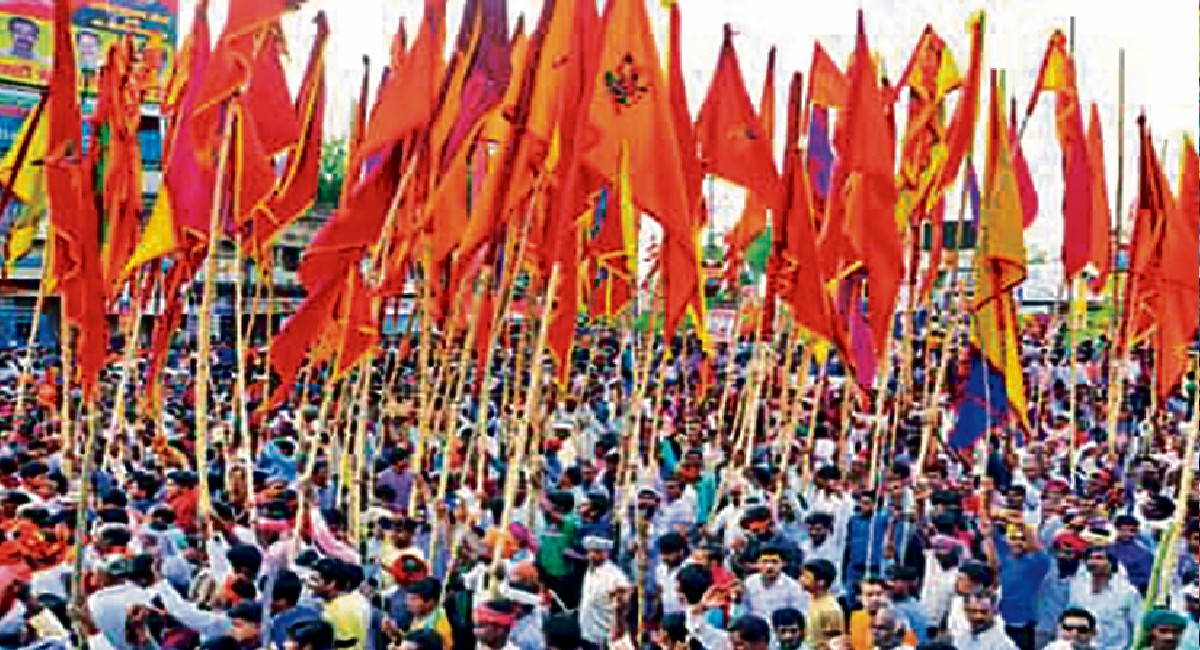
The Ram Navami procession of the capital Ranchi is inspired by Hazaribagh. The tradition of hoisting the Mahavir flag has been going on since 1924 at Jhanda Chowk, Hazaribagh. Ranchi residents also participated in this procession. After witnessing Hazaribagh’s Ram Navami for five consecutive years, the famous businessmen of that time decided to take out a procession in Ranchi also. Then in 1929, the Ram Navami procession started for the first time from Mahavir Chowk. The first procession was taken out under the leadership of only five people. This initiative was taken by Dr. Ramakrishna Lal and his brother Krishna Lal of Mahavir Chowk, Upper Bazaar. Both the brothers were supported by three friends Jagannath Sahu, Gulab Narayan Tiwari and Laxman Ram Mochi. 40-50 people from nearby areas participated in the first procession and carried Mahavir flag till Tapovan temple.
Every year the Ram Navami procession of Ranchi started becoming grander. Rajkumar Gupta, lifelong president of Chaiti Durga Puja Committee, said that in 1936, the members of the temple committee started taking out processions from the ancient Mahavir Temple, Mahavir Chowk. The procession held between 1929 and 1936 united everyone, which later took a grand form.
Hanuman ji’s figure was cut from cloth and prepared.
Late Krishna Lal had also seen people in Hazaribagh hoisting the flag of Hanuman ji in the temple. In Ranchi also he went to a tailor to get Mahavir flags ready. Asked for saffron colored cloth and made the figure of Hanuman ji on it. Cut the figure of Hanuman ji with scissors and asked to attach it to another cloth. The tailor also prepared the Ram Navami flag like other flags. After this, it was decided to take out a procession in Ranchi on the Navami of Shukla Paksha of Chaitra month (17 April 1929). After the puja, devotees left for Tapovan temple with two flags. Seeing the procession, the devotees gathered with devotion.
There were four groups in the 1980s, now 288 Akharas
Rajkumar Gupta explains: In the 1980s, the Ram Navami procession had become very large. Ranchi city was divided into four groups (zones). The eastern region included Namkum and Lowadih, the western region included Bajra (Ratu Road area), Pandara (Itki Road area), the northern region included Badgai and Bariatu and the southern region included Argora and Pundag. From these places, processions started coming out from different Akharas, Hanuman Temple and other temples. Ram devotees from all areas used to unite at Mahavir Chowk, after which the procession proceeded till Tapovan temple. With time, separate Mahavir Akharas were formed in every area. At present Ranchi is divided into seven groups, which have 288 Akharas.
People started gathering in the procession from 1930.
In the year 1930, under the leadership of late Nanu Bhagat, a procession was taken out from Gwala Toli located on Ratu Road. In order to continue the tradition, a meeting regarding the procession was held on April 5, 1935 in Sant Lal Library (presently Govind Bhawan) located in Upper Bazaar. Many people from Ranchi participated in this. Shri Mahavir Mandal was formed in this meeting. Late Mahant Gyan Prakash alias Naga Baba and General Secretary Dr. Ramakrishna Lal became the first president of the Mandal. After this, the procession continued under the leadership of Late Nanu, Late Kapildev, Late Ganga Prasad Bunia, Late Jagdish Narayan Sharma, Late Harvansh Lal Oberoi, Late Parshuram Sharma, Late Saryu Yadav and Late Kishore Singh Yadav.
In 1936, members of the Chaiti Durga Puja Committee took out the first procession.
In the year 1926, Chaiti Durga Puja started by installing a Kalash near the haunted pond. The members of the temple joined the Mahavir Temple, Mahavir Chowk and started taking out the Ram Navami procession from 1936. A procession was taken out under the leadership of Nandu Sahu, Gyan Prakash Sagar Baba, Loknath Saav. Ram devotees used to have Mahavir flags, conch shells and bells in their hands. Along with him, members of the temple committee and other devotees used to go to Tapovan temple. With time the number of devotees increased. At that time, the help of vehicles was taken from the brick kiln operators of the city to take out the procession. In this, people like Ishwar Dayal Singh, Jhulan Singh, Mantu Sahu, Suraj Narayan Singh used to provide vehicles.
Presently Bharat Milaap takes place at four confluence places.
Even today the Sangam place is given importance in the Ram Navami procession. Mahavir groups from different areas of the city reach these confluence points. The tradition of coming together is still seen as Bharat Milap. Ram devotees and devotees arriving from different corners of the city embrace each other and move towards the Tapovan temple. Even today Mahavir Chowk is considered to be the first confluence place, where Ram devotees from the western area of the city gather. The second confluence point is Shaheed Chowk, the third is Albert Ekka Chowk and the fourth confluence is Sujata Chowk. At all these confluence points, the tradition of moving forward by mixing flag with flag continues.
Also Read : Chaitra Navratri 9th Day: Worship Goddess Siddhidatri on the ninth day of Navratri, know the auspicious time, worship method and aarti.
